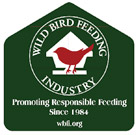Welcome to Brome Bird Care Support
Backyard Sanctuary
![]()
6 steps to turn your yard into a bird sanctuary
Birds need your help! Populations of many kinds of birds are declining. Habitat loss and degradation, disease, collisions with man-made structures and a host of other factors contribute to these declines. You can help by turning your yard into a sanctuary for birds. Here are six steps you can take to make the future brighter for birds:
1.Put out the welcome mat! Habitat loss is the biggest challenge facing birds. You can help by making your neighborhood more attractive to birds by landscaping with native plants that provide natural food sources, shelter from the elements and predators, and nesting sites. Providing feeders, nest boxes and water also benefits birds. To learn how, stop by your local wild bird food retailer.
2.Prepare a proper menu Providing the appropriate foods year round will attract more birds to your yard and help ensure that they have a safe and nutritious diet. Refill feeders regularly with food desired by birds in your area. To pick the best menu, stop by your local wild bird food retailer.
3.Keep feed and feeding areas clean To help reduce the possibility of disease transmission in birds, clean feeders and feeding areas at least once a month. Plastic and metal feeders can go in the dishwasher, or rinse these and other styles with a 10% solution of bleach and warm water. Scrub birdbaths with a brush and replace water every three to five days to discourage mosquito reproduction. Rake up and dispose of seed hulls under feeders. Moving feeders periodically helps prevent the buildup of waste on the ground. Keep seed and foods dry; discard food that smells musty, is wet or looks moldy. Hummingbird feeders should be cleaned every three to five days, or every other day in warm weather. It’s good hygiene to wash your hands after filling or cleaning feeders.
4.Birds and chemicals don’t mix Many pesticides, herbicides and fungicides are toxic to birds; avoid using these near areas where birds feed, bathe or rest. Always follow directions provided by chemical manufacturers. For additional information visit your wild bird food retailer.
5.Keep cats away from birds Scientists estimate that cats probably kill hundreds of millions of birds each year in the U.S. This is a big problem, but it’s easy to fix. Many people who enjoy feeding birds also love cats. The best solution is tokeep cats indoors. They will lead longer, healthier lives, and your yard will be safer for birds. Install feeders in areas not readily accessible to cats or install fences or other barriers to help keep stray cats from feeder areas. Collar bells, de-clawing and keeping cats well fed will not solve the problem.
6.Reduce window collisions Collisions with glass windows kill millions of wild birds every year. Depending on their size and location, some windows reflect the sky or vegetation, and birds are fooled into thinking they can fly through them. To eliminate this problem identify windows that cause collisions (typically larger, reflective windows, those near the ground, or those that “look through” the house). Attaching decorative decals or other decorations to the outside surface of the glass can reduce reflections. Feeder birds fleeing predators are vulnerable to window collisions. If this is happening at your house, consider moving feeders within three feet of the windows so that birds cannot accelerate to injury level speeds while flying away. Problem windows can be covered with a screen so that birds bounce off, rather than hit the glass.
The information contained here is designed to assist birding enthusiasts in their efforts to attract a variety of birds to their property, as well as to serve as a guide to providing a healthy environment. WBFI and its member companies hope you find this information helpful in creating your own wild bird sanctuary, and wish you many years of happy viewing! You can help change the world and make it a better place for birds. The most important step you can take is to get started! Following the six steps presented here is a great start. Be sure to learn more about birds and how you can help by getting involved with the organizations listed below, and with others committed to conserving bird and wildlife habitats.  Representatives from Cleveland MetroParks, Aurora University, and Muhlenberg College, as well as the following organizations contributed to the development of this brochure. • American Bird Conservancy – www.abcbirds.org • American Birding Association – www.americanbirding.org • Bird Conservation Alliance – www.birdconservationalliance.org • Cornell Laboratory of Ornithology – www.birds.cornell.edu • Massachusetts Audubon Society – www.massaudubon.org • National Audubon Society – www.audubon.org • National Fish and Wildlife Foundation – www.nfwf.org • National Wildlife Federation – www.nwf.org • The Wildlife Society – www.wildlife.org • U.S. Fish and Wildlife Service – www.fws.gov • The Wild Bird Feeding Industry and its member companies – www.wbfi.org The Wild Bird Feeding Industry (WBFI) sponsored development of this brochure. WBFI is an association dedicated to the progressive expansion of the wild bird feeding industry. ©2004 Wild Bird Feeding Industry
Representatives from Cleveland MetroParks, Aurora University, and Muhlenberg College, as well as the following organizations contributed to the development of this brochure. • American Bird Conservancy – www.abcbirds.org • American Birding Association – www.americanbirding.org • Bird Conservation Alliance – www.birdconservationalliance.org • Cornell Laboratory of Ornithology – www.birds.cornell.edu • Massachusetts Audubon Society – www.massaudubon.org • National Audubon Society – www.audubon.org • National Fish and Wildlife Foundation – www.nfwf.org • National Wildlife Federation – www.nwf.org • The Wildlife Society – www.wildlife.org • U.S. Fish and Wildlife Service – www.fws.gov • The Wild Bird Feeding Industry and its member companies – www.wbfi.org The Wild Bird Feeding Industry (WBFI) sponsored development of this brochure. WBFI is an association dedicated to the progressive expansion of the wild bird feeding industry. ©2004 Wild Bird Feeding Industry

